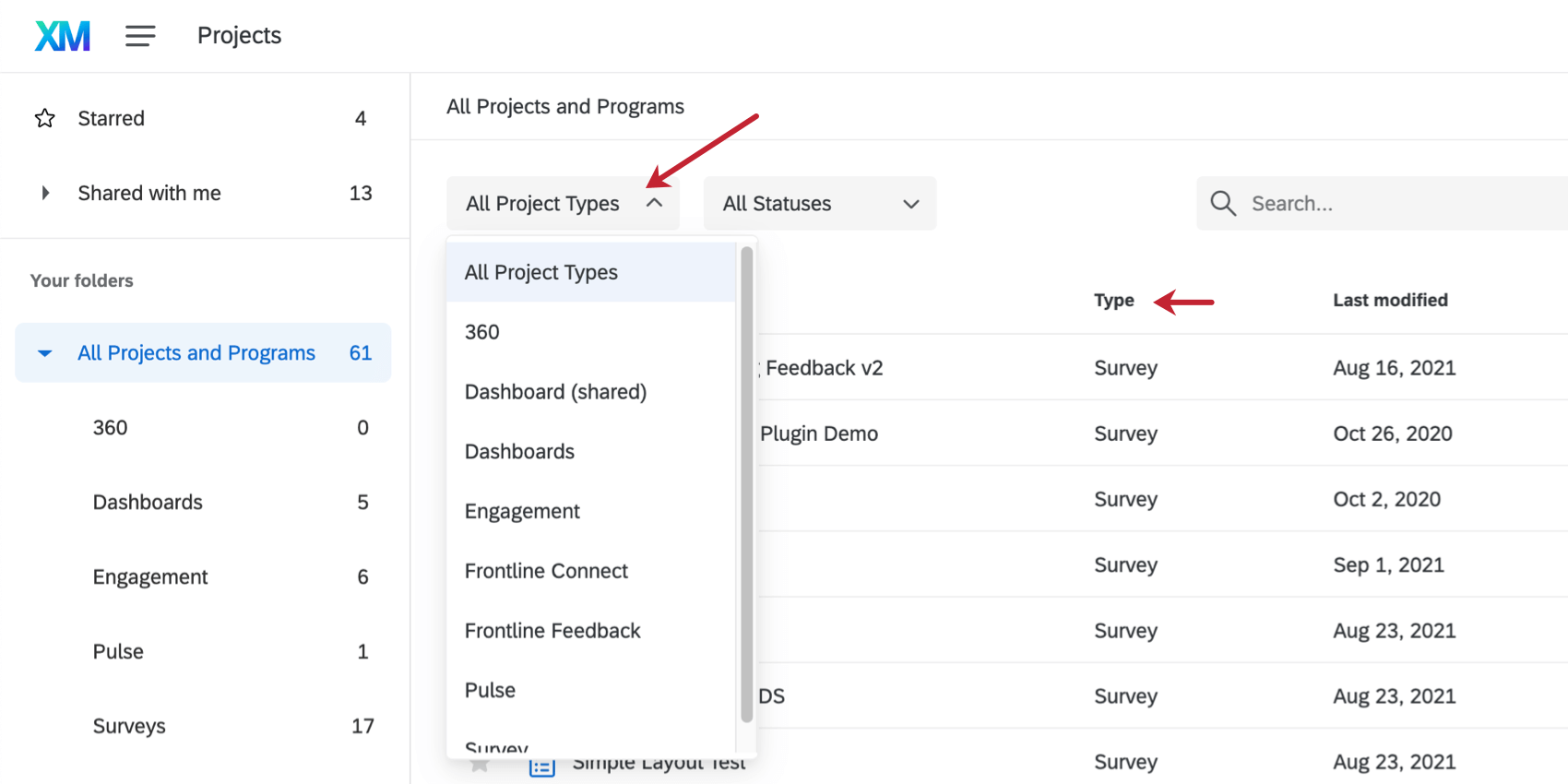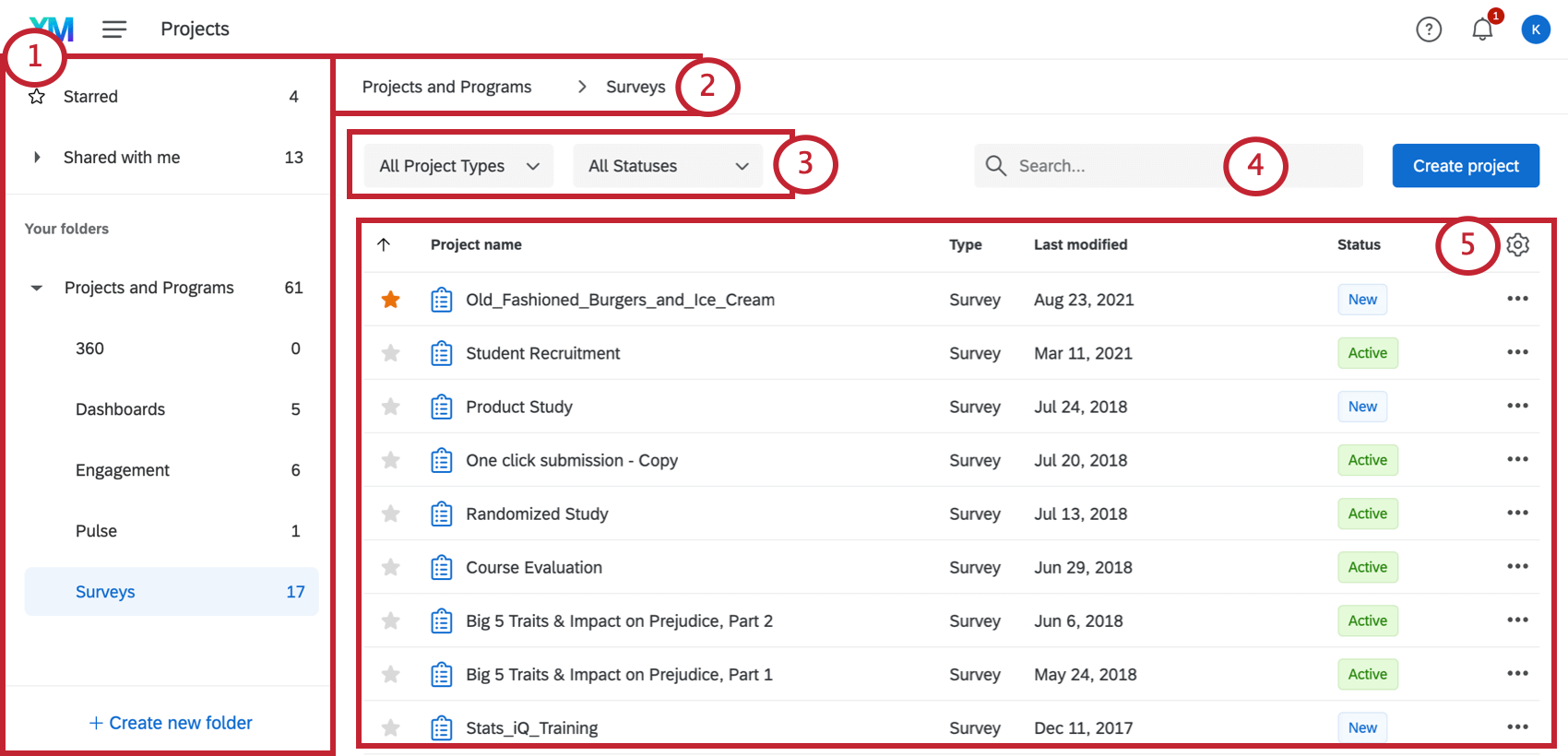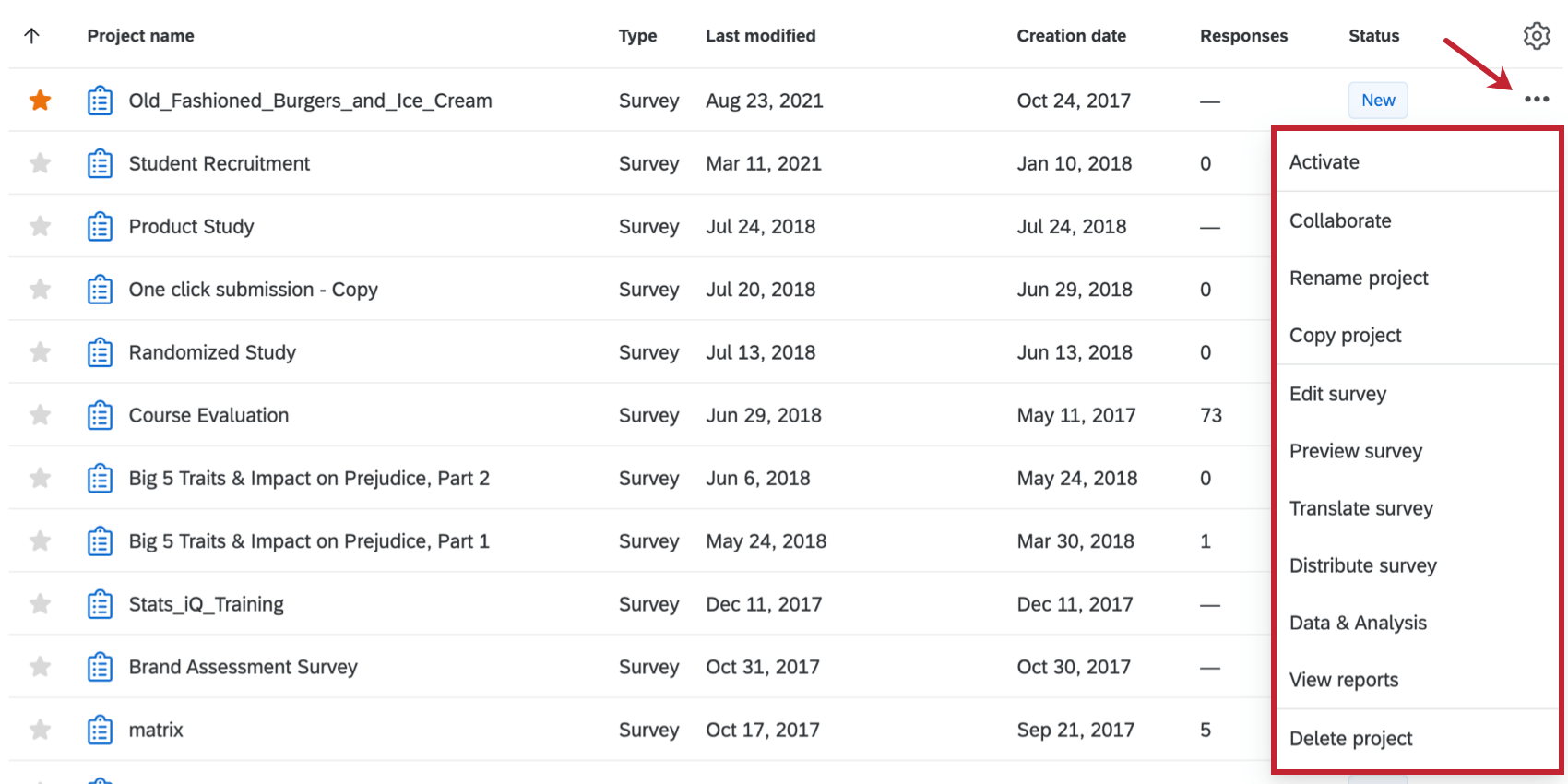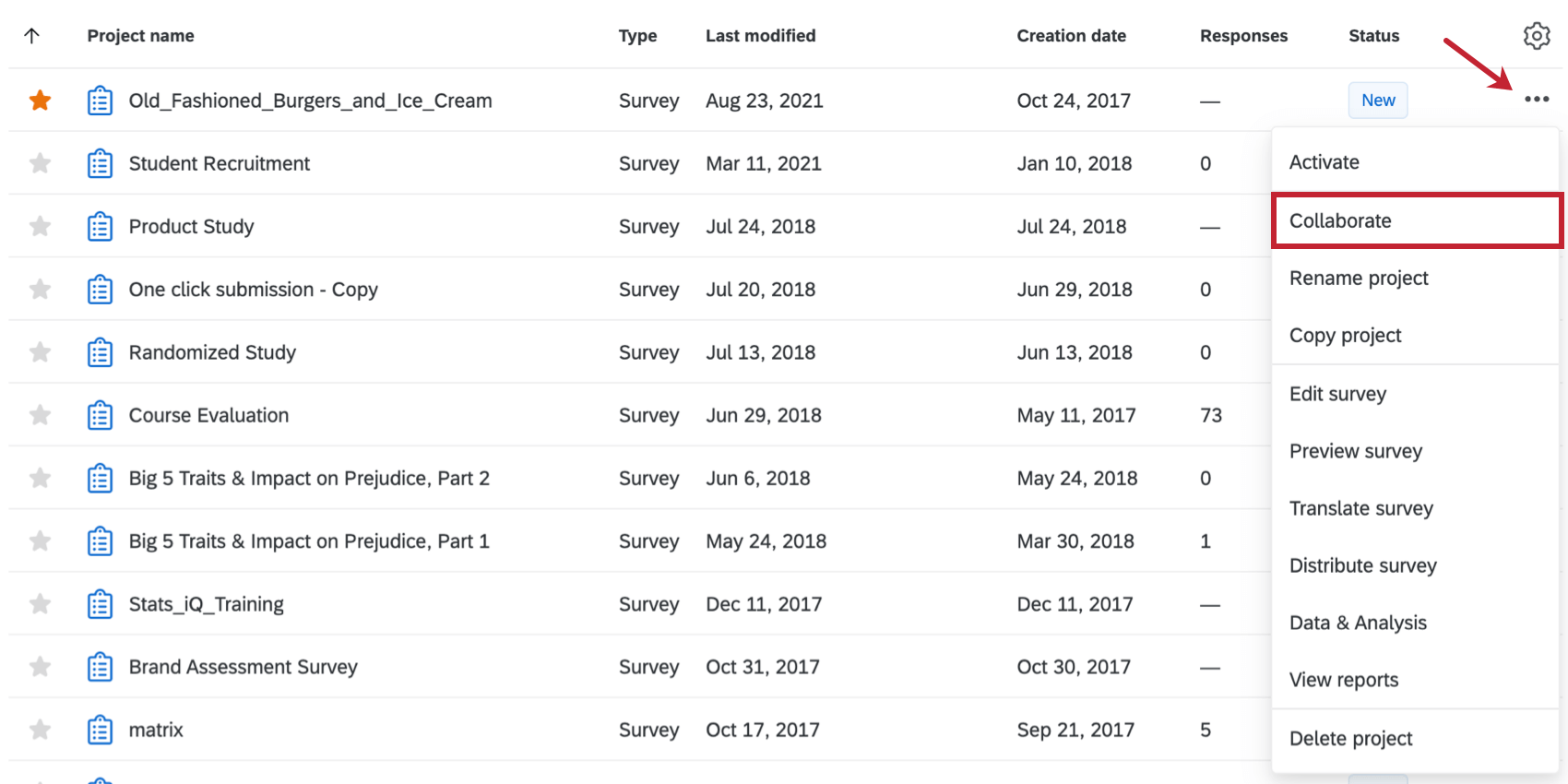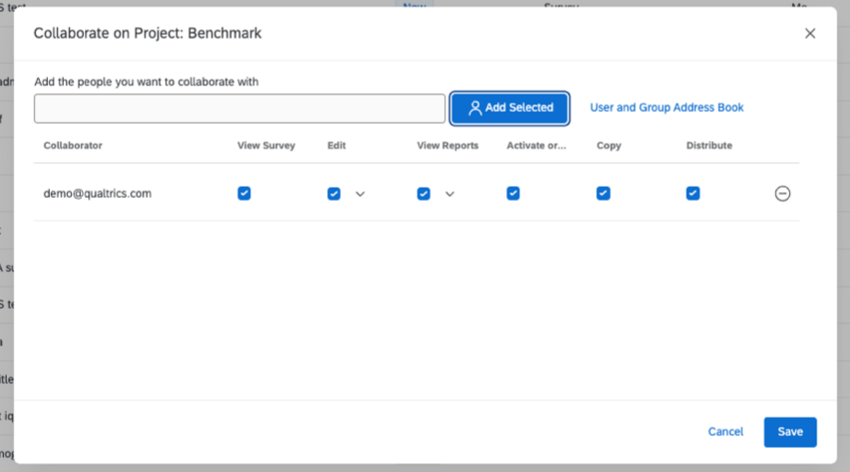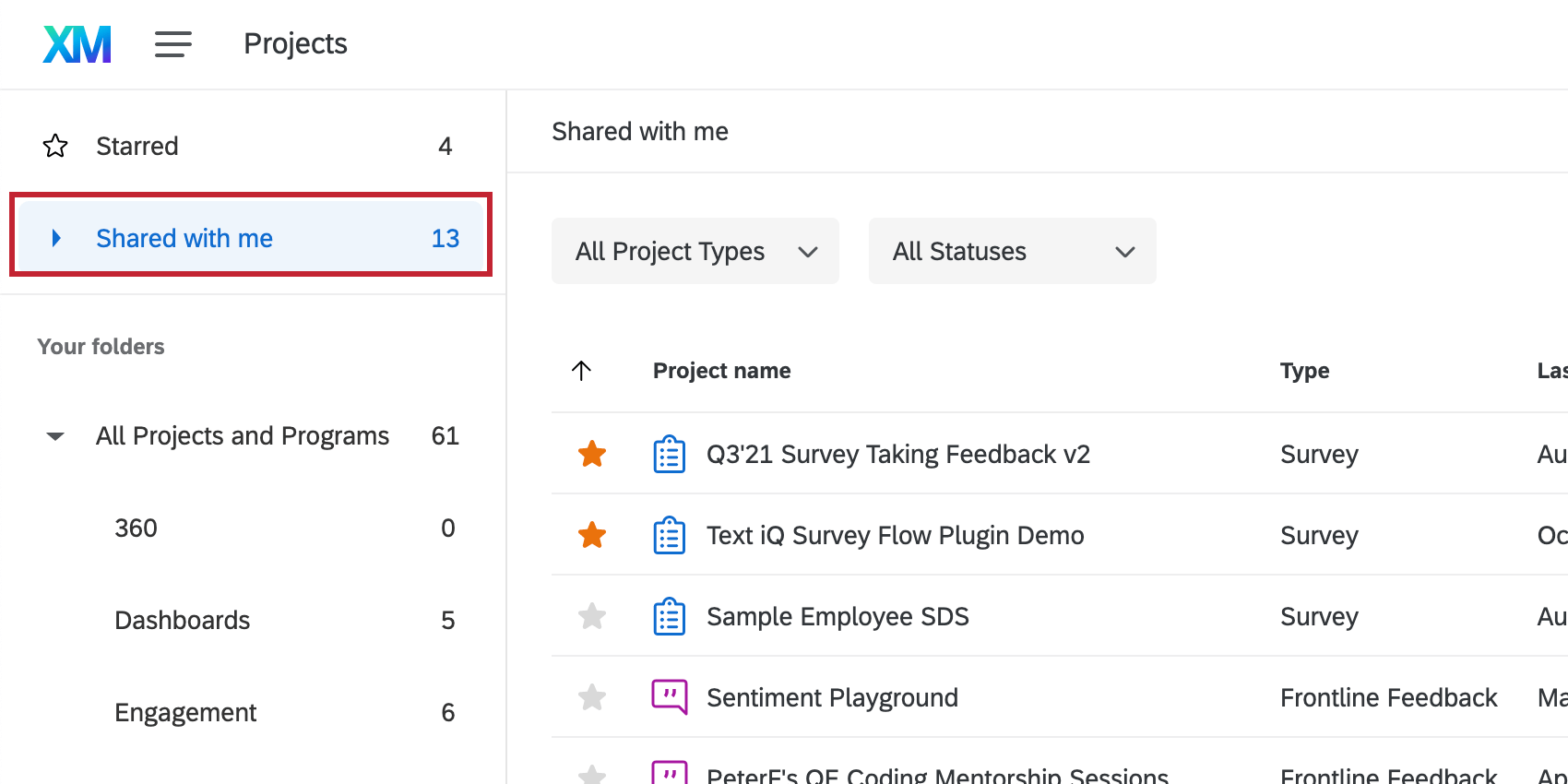Projects Basic Overview
About the Projects Page
The Projects page is a one-stop shop listing all the XM projects you’ve created and that have been shared with you. The Projects page can be accessed in 2 ways:
- Open the navigation menu on any page of the Qualtrics website and select Projects.
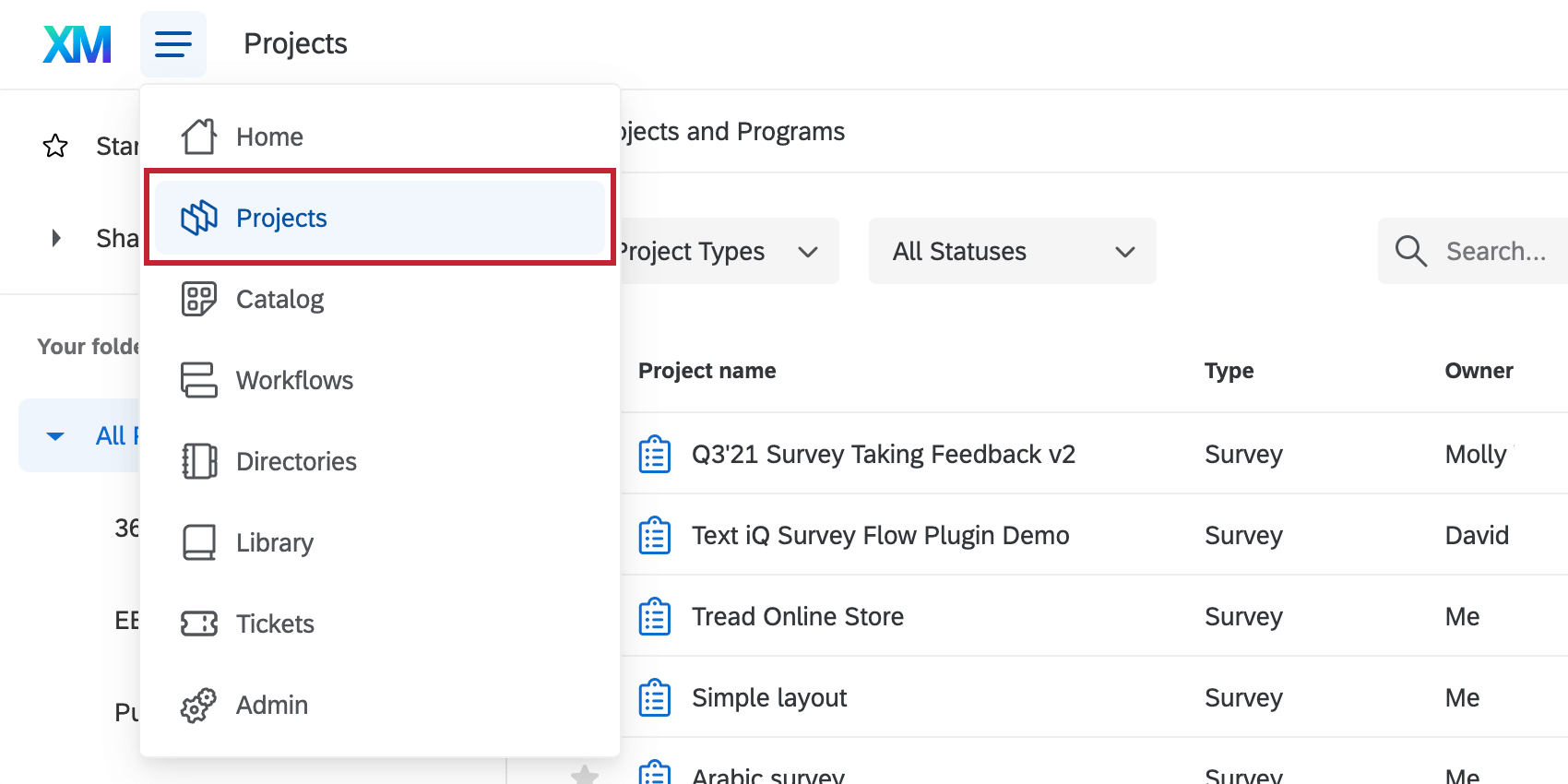
- When you first login and land on Home, you can also click See all projects.
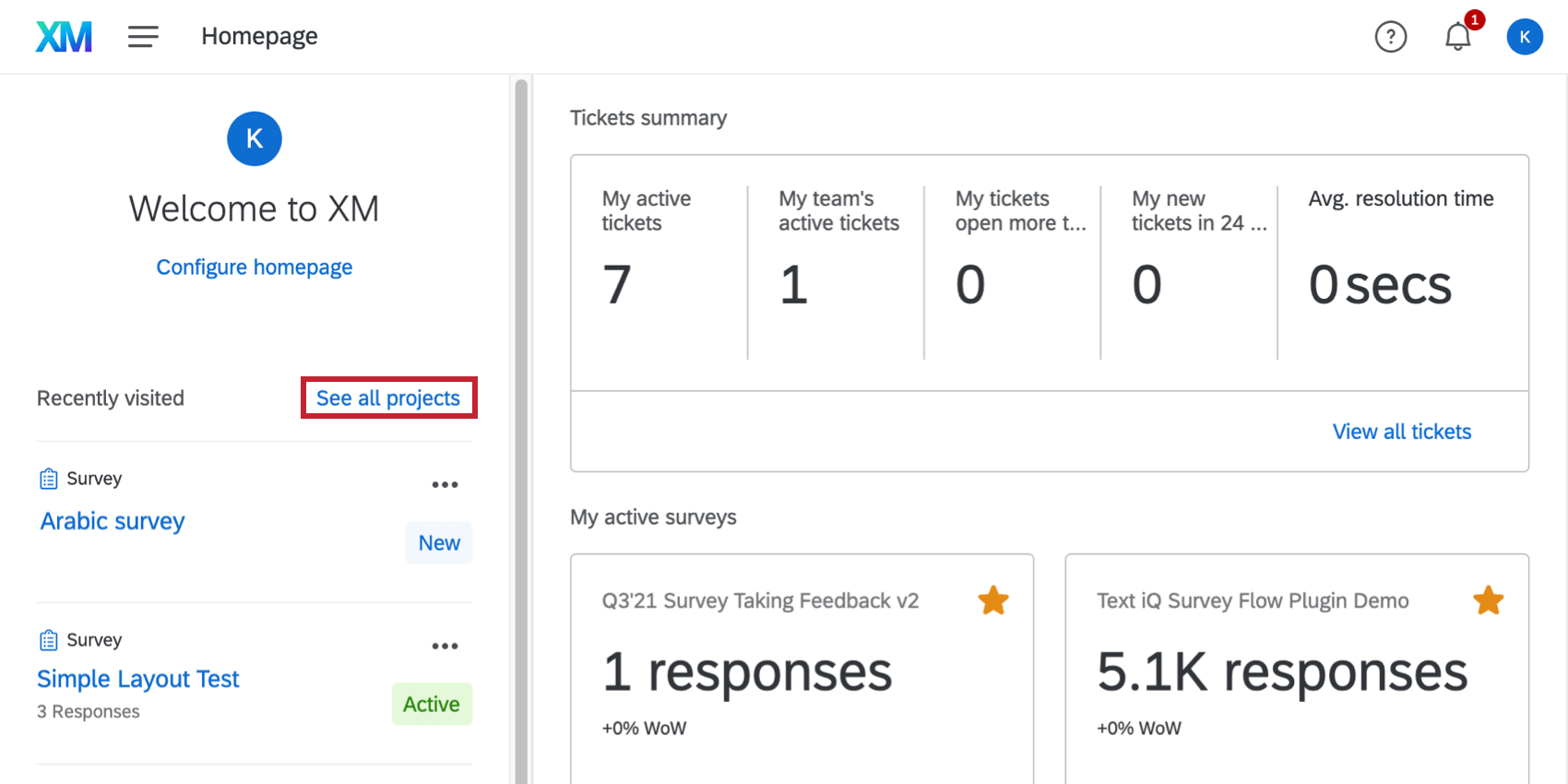
From the Projects page, you can do the following:
- Create new projects.
- Organize, sort, search, and view your projects.
- Collaborate on projects with colleagues.
- Identify your projects by their project type.
Available Project Types
There are many different types of projects available to you. When you create a new project in Qualtrics, you have several options to select for the Project type. Each Qualtrics software solution has its own unique strengths, so the project type helps determine which software you can use.
- Survey: With survey projects, you can create a survey, distribute it to respondents, analyze the data, and build reports, all inside 1 project.
- Imported Data: If you don’t want to create a survey before importing data to Stats iQ for analysis, you can create a standalone Stats iQ project.
- Website & App Insights: This project type allows you to seamlessly integrate feedback surveys with your website.
- Dashboards Project: Visualize your research by building shareable, dynamic reports. This project type is also called CX Dashboards.
- Conjoint: Conjoint analysis is a market research technique used to identify consumer preferences and evaluate the product trade-offs they would make. Our choice-based model allows your respondents to provide feedback so you can easily narrow down the types of packages and products you should offer.
- MaxDiff: MaxDiff (Maximum Difference) is an advanced survey research technique used to obtain preference and importance scores for multiple items. This is done by presenting respondents with samples of the full list of items you wish to assess, and then having them mark the items they prefer the most and the items they prefer the least in each set.
- Frontline Feedback: Collect, organize, and prioritize suggestions from users in your Qualtrics organization.
- Assorted Guided Solutions: When you create a guided solution, its name will appear as the project type – for example, “Pricing Study (Gabor Granger)” or “Brand Tracker.”
- Reputation Management: Online Reputation management is a means of understanding and managing your brand’s online reputation. Here, you can create dynamic dashboards that report on reviews you receive, and trigger close-the-loop responses when reviews come in that require action.
- Ticket Feedback: Attaches to ticket tasks and lets ticket owners provide additional follow-up details.
- Programs: Organize different related projects in 1 container. Depending on your license, you may be able to access expertly-designed programs, or build your own from scratch.
- Product Test: Product tests are a method to gather feedback on a new product or prototype. You can evaluate the performance and identify strengths and weaknesses of your product before it is widely available.
- Bain Outer Loop: Bain Outer Loop is a means of addressing customer complaints by empowering CX improvements within your organization. In this project you can track elevated issues, common themes, and document proposed solutions. This project also contains a pre-built dashboard to track elevation progress.
- Coaching Recommendations: Configure how coaching recommendations will be displayed within a Customer Care App. After configuration these projects can be selected within an instance of a Customer Care App so you can visualize agent performance and coaching within several informative widgets.
You can also find a list of Employee Experience projects, such as Engagement, 360, Lifecycle, and more. See Types of Employee Experience Projects for more details.
In addition to sorting projects by type, you can filter by project type. See more under Organizing, Viewing, Searching, & Sorting Projects.
Creating New Projects
A typical project consists of a survey, a distribution record, responses, and reports. You can start with any project type available to you.
New projects are created on the Catalog page. You can also easily start from Home or the Projects page itself. Below, we’ll show you what creating a survey looks like on the Projects page.
- From any folder on the Projects page, click Create project.
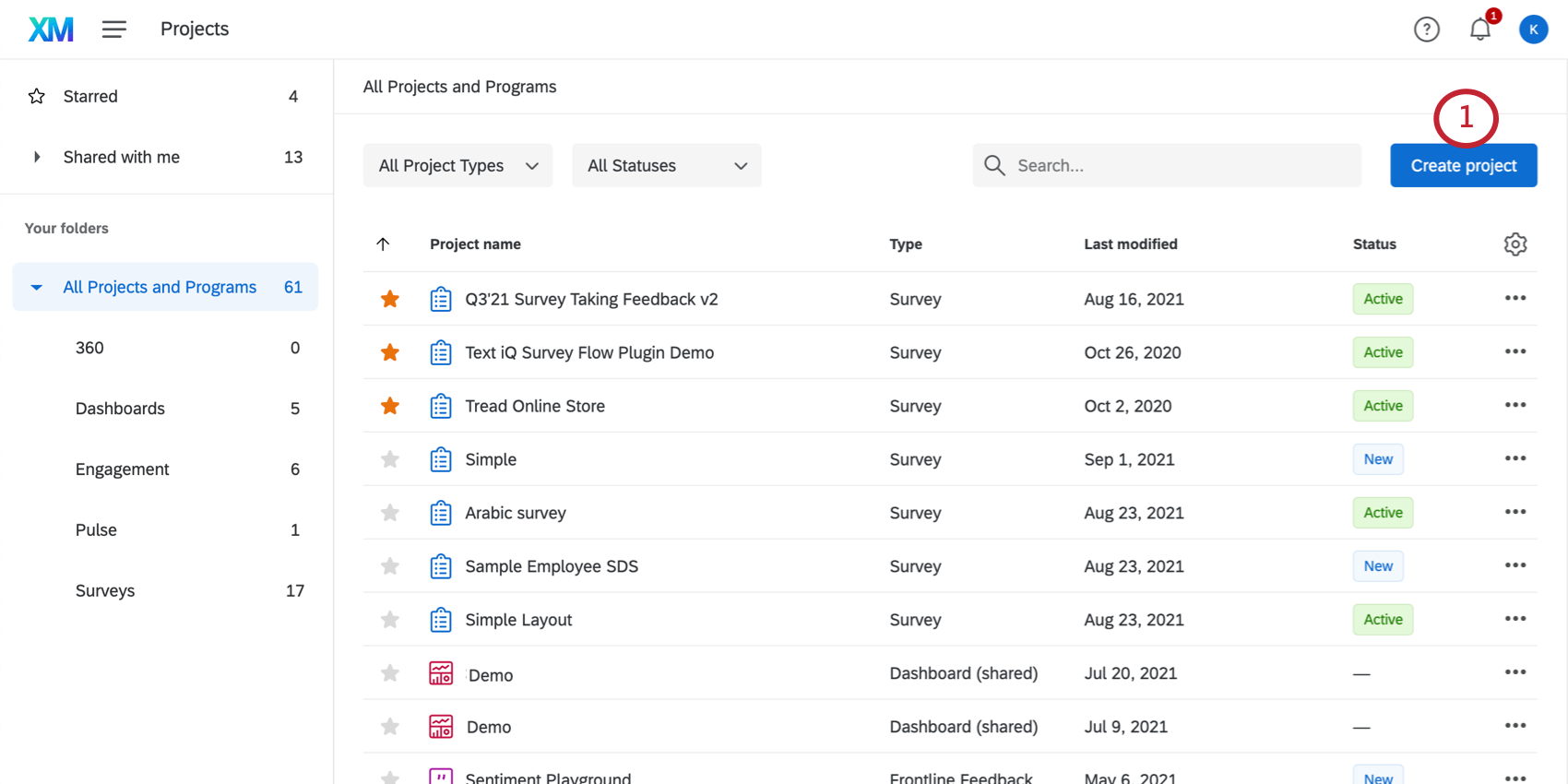 Qtip: The folder you start in doesn’t affect where your project will be stored once it’s created.
Qtip: The folder you start in doesn’t affect where your project will be stored once it’s created. - Scroll through the sections or filter or search to find the type of project you’d like to create.
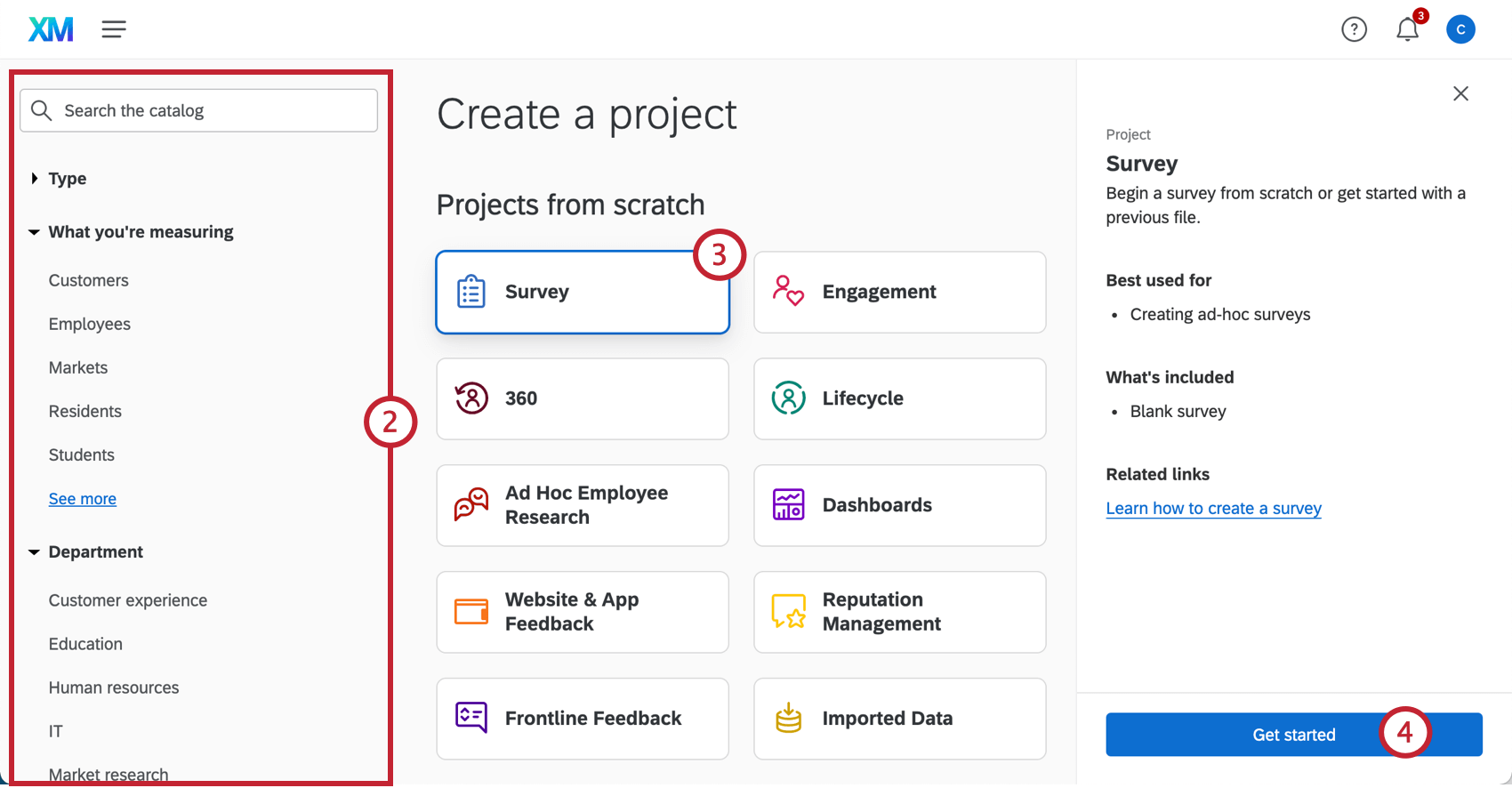
- Select from among the many project creation options, including Survey or one of the solutions offered.
- Click Get Started.
Go to the Creating a Project page for step-by-step examples of how to create new projects using any of these options.
Organizing, Viewing, Searching, & Sorting Projects
The Projects page displays practical, at-a-glance information to help you organize, view, monitor, track, and sort through your projects. For example:
- View and organize projects by folder or category. You can choose between:
- See the folder you’re located inside along the left or the top of the page.
- Filter by project types or statuses.
- Search for projects, programs, and folders by typing terms into the field. This will search by name, survey ID, or project type.
- View different information about your projects and click column headers to sort by that information. You can customize what columns appear here using the gear button on the far-right.
On the far-right of every project name you’ll see 3 dots that open the project actions drop-down menu. From here you can activate, rename, copy, edit, translate, delete your projects, and more.
Go to the Organizing & Viewing Your Projects page for step-by-step examples of how to get the most value and power out of the Projects page. This page goes through:
- The project actions drop-down menu’s options.
- The organization of your folders and categories.
- The sorting and searching of your projects.
Collaborating On Projects
Collaborating on projects is as easy as clicking Collaborate from the project actions drop-down menu.
If your account has the proper permissions, you can collaborate with:
- Individuals inside your organization.
- Groups within your organization.
- Collaborators outside your organization.
To begin collaborating, enter a colleague’s email address in the Collaborate popup menu.
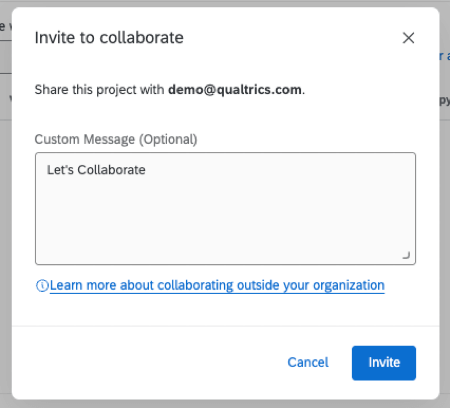
- Full access rights: Allows collaborators unrestricted access (while still protecting your account information).
- Limited access rights: The Collaborate on Project popup menu lets you customize access to specific collaborator needs.
For example, translators may be limited to “Edit” permissions only while their “Activate/Deactivate” and “Distribute” permissions are disabled.
When people invite you to collaborate, their projects will show up in your Projects page. There is even a folder called Shared with me to help you find these projects quickly.
Navigate to the Collaborating on a Project page for step-by-step examples of how to collaborate on projects.
Variations for Different Project Types
The Projects page has a lot of functions that are shared by all types of projects. You can view all of your projects on this page, and you can star them and sort them into folders however you see fit.
However, there are a few key differences to keep in mind, especially regarding:
- Collaboration
- Management (such as copying projects, status changes, and project actions)
Luckily, we have resources to help with these key differences. See the linked pages below for more information about collaboration and management in different project types.
Collaborating on Different Project Types
- Survey projects: See Collaborating on Survey Projects. Ticket feedback surveys also work this way.
- Employee Experience: See Collaborating on Projects (EX). Includes Engagement, 360, Lifecycle, and Ad Hoc Employee Research.
- Programs: See Sharing a Program. Includes Pulses.
- CX Dashboards projects: See Adding Project Administrators to a Dashboard (CX).
- Website / App Insights: See Adding Users to the Project.
- Conjoint and MaxDiff: See Collaborating on Conjoints & MaxDiffs.
- Reputation Management: See Sharing Reputation Management Projects.
- Imported Data projects: Similar user interface to collaborating on programs. See Sharing a Program.
- Product Test projects: See Collaborating on Product Test Projects.
- Bain Outer Loop projects: Collaborating this project with a user will add them as project admins. To create elevations within the project, they’ll need to be assigned an Outer Loop persona. See User Roles & Personas.
Managing Different Project Types
- Employee Experience: See Managing Projects (EX). Includes Engagement, 360, Lifecycle, and Ad Hoc Employee Research.
- Programs: See Programs. Includes Pulses.
- Website / App Insights: See Managing Website & App Insights Projects.
- Conjoint and MaxDiff: See Creating & Managing Conjoint & MaxDiff Projects.
- Reputation Management: See Getting Started with Online Reviews.
- Imported Data projects: See Project Actions.

